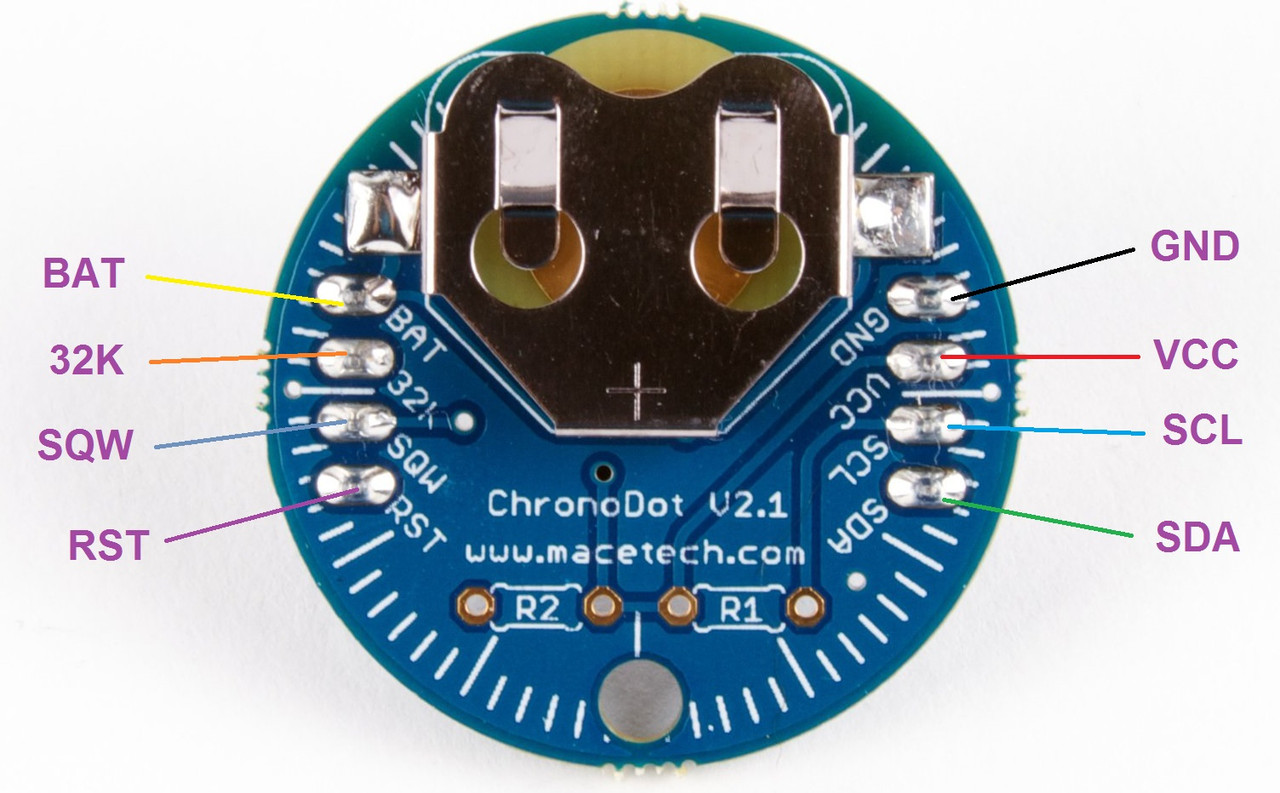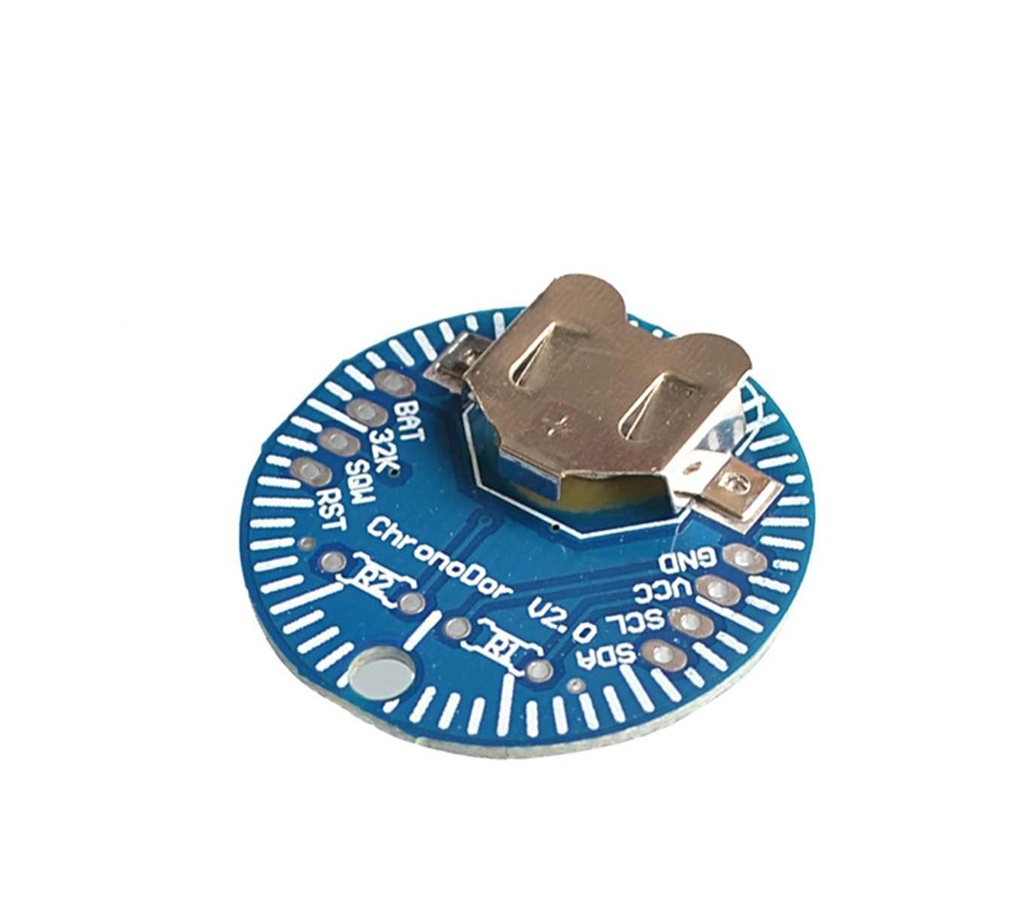Features:
- Temperature-Compensated Real-Time Clock: Built on the DS3231 RTC with a TCXO feature to ensure stability across temperatures.
- High Accuracy: ±3.5ppm accuracy over -40°C to +85°C, equivalent to less than 1-minute drift per year.
- Long Battery Life: Includes a CR1632 battery lasting up to 8 years (if I2C is used only when powered by 5V).
- Simple I2C Interface: Compatible with DS1337/DS1307 register maps and works with Arduino, Basic Stamp, etc.
- Wide Voltage Range: Operates from 2.3V to 5.5V, supporting both 3.3V and 5V systems.
- Small Form Factor: 1.2" diameter PCB, 0.1" pin spacing, and 0.9" header spacing. Fits breadboards with mounting holes available.
- Additional Pins: BAT, RST, SQW, and 32K provide extended functionality like battery monitoring, resets, square wave outputs, and 32.768kHz clock signal.
Principle of Work:
The DS3231SN chip at the core uses an internal crystal oscillator and temperature-adjusted tuning capacitors. It continuously monitors and adjusts frequency based on internal temperature sensing, ensuring minimal drift. The ChronoDot communicates over I2C and includes additional features like SQW and reset pins for integration with external systems.
Pinout of the Module:

- VCC: 3.3V to 5.5V power input
- GND: Ground connection
- SCL: I2C clock input (up to 400kHz)
- SDA: I2C data line (bidirectional)
- SQW/INT: Square wave output (1Hz–32.768kHz) or interrupt signal
- 32K: Outputs a 32.768kHz clock signal
- RST: Active-low reset pin
- VBAT: Backup battery input (2.0V–3.5V)
Applications:
- Electronic Instruments (oscilloscopes, counters)
- Data Loggers
- Automation Systems (scheduling, control)
- Security Systems (CCTV, access control)
- Communication Systems (network switches, wireless sync)
- Robotics (motion coordination)
Circuit:

- VCC → Arduino 5V
- GND → Arduino GND
- SDA → Arduino A4
- SCL → Arduino A5
Library:
- Download RTClib from GitHub.
- Extract and rename the folder to
RTClib.
- Place it inside Arduino’s
libraries directory.
- In Arduino IDE:
Sketch → Include Library → RTClib.
Code Example:
#include <Wire.h>
#include <RTClib.h>
RTC_DS3231 rtc;
void setup() {
Serial.begin(9600);
Wire.begin();
rtc.begin();
if (!rtc.begin()) {
Serial.println("Couldn't find RTC");
while (1);
}
if (rtc.lostPower()) {
Serial.println("RTC lost power, setting the time!");
rtc.adjust(DateTime(F(__DATE__), F(__TIME__)));
}
}
void loop() {
DateTime now = rtc.now();
Serial.print(now.year()); Serial.print('/');
Serial.print(now.month()); Serial.print('/');
Serial.print(now.day()); Serial.print(' ');
Serial.print(now.hour()); Serial.print(':');
Serial.print(now.minute()); Serial.print(':');
Serial.print(now.second()); Serial.println();
delay(1000);
}
Technical Details:
| Controller: |
Maxim DS3231SN |
| Function: |
Temperature-compensated RTC |
| Accuracy: |
±3.5ppm @ -40°C to +85°C (~1 min/year) |
| Power Supply: |
2.3V to 5.5V DC |
| Current: |
200μA (active), 840nA (timekeeping) |
| PCB Size: |
1.2" diameter |
| Pin Spacing: |
0.1" |
| Header Spacing: |
0.9" |
Resources:
Comparisons:
- Size: ChronoDot V2 is compact (19×16×5mm); DS3231 varies by manufacturer.
- Accuracy: Both offer high accuracy; ChronoDot adds OCXO for better long-term stability.
- Memory: ChronoDot includes battery-backed SRAM and EEPROM; DS3231 modules typically do not.
- Cost: ChronoDot is more expensive due to its precision and extra features.
Conclusion: Both modules offer excellent timekeeping. ChronoDot RTC V2 is ideal for precision-critical applications, while the DS3231 is a budget-friendly, capable alternative.
Features:
- Temperature-Compensated Real-Time Clock: Built on the DS3231 RTC with a TCXO feature to ensure stability across temperatures.
- High Accuracy: ±3.5ppm accuracy over -40°C to +85°C, equivalent to less than 1-minute drift per year.
- Long Battery Life: Includes a CR1632 battery lasting up to 8 years (if I2C is used only when powered by 5V).
- Simple I2C Interface: Compatible with DS1337/DS1307 register maps and works with Arduino, Basic Stamp, etc.
- Wide Voltage Range: Operates from 2.3V to 5.5V, supporting both 3.3V and 5V systems.
- Small Form Factor: 1.2" diameter PCB, 0.1" pin spacing, and 0.9" header spacing. Fits breadboards with mounting holes available.
- Additional Pins: BAT, RST, SQW, and 32K provide extended functionality like battery monitoring, resets, square wave outputs, and 32.768kHz clock signal.
Principle of Work:
The DS3231SN chip at the core uses an internal crystal oscillator and temperature-adjusted tuning capacitors. It continuously monitors and adjusts frequency based on internal temperature sensing, ensuring minimal drift. The ChronoDot communicates over I2C and includes additional features like SQW and reset pins for integration with external systems.
Pinout of the Module:

- VCC: 3.3V to 5.5V power input
- GND: Ground connection
- SCL: I2C clock input (up to 400kHz)
- SDA: I2C data line (bidirectional)
- SQW/INT: Square wave output (1Hz–32.768kHz) or interrupt signal
- 32K: Outputs a 32.768kHz clock signal
- RST: Active-low reset pin
- VBAT: Backup battery input (2.0V–3.5V)
Applications:
- Electronic Instruments (oscilloscopes, counters)
- Data Loggers
- Automation Systems (scheduling, control)
- Security Systems (CCTV, access control)
- Communication Systems (network switches, wireless sync)
- Robotics (motion coordination)
Circuit:

- VCC → Arduino 5V
- GND → Arduino GND
- SDA → Arduino A4
- SCL → Arduino A5
Library:
- Download RTClib from GitHub.
- Extract and rename the folder to
RTClib.
- Place it inside Arduino’s
libraries directory.
- In Arduino IDE:
Sketch → Include Library → RTClib.
Code Example:
#include <Wire.h>
#include <RTClib.h>
RTC_DS3231 rtc;
void setup() {
Serial.begin(9600);
Wire.begin();
rtc.begin();
if (!rtc.begin()) {
Serial.println("Couldn't find RTC");
while (1);
}
if (rtc.lostPower()) {
Serial.println("RTC lost power, setting the time!");
rtc.adjust(DateTime(F(__DATE__), F(__TIME__)));
}
}
void loop() {
DateTime now = rtc.now();
Serial.print(now.year()); Serial.print('/');
Serial.print(now.month()); Serial.print('/');
Serial.print(now.day()); Serial.print(' ');
Serial.print(now.hour()); Serial.print(':');
Serial.print(now.minute()); Serial.print(':');
Serial.print(now.second()); Serial.println();
delay(1000);
}
Technical Details:
| Controller: |
Maxim DS3231SN |
| Function: |
Temperature-compensated RTC |
| Accuracy: |
±3.5ppm @ -40°C to +85°C (~1 min/year) |
| Power Supply: |
2.3V to 5.5V DC |
| Current: |
200μA (active), 840nA (timekeeping) |
| PCB Size: |
1.2" diameter |
| Pin Spacing: |
0.1" |
| Header Spacing: |
0.9" |
Resources:
Comparisons:
- Size: ChronoDot V2 is compact (19×16×5mm); DS3231 varies by manufacturer.
- Accuracy: Both offer high accuracy; ChronoDot adds OCXO for better long-term stability.
- Memory: ChronoDot includes battery-backed SRAM and EEPROM; DS3231 modules typically do not.
- Cost: ChronoDot is more expensive due to its precision and extra features.
Conclusion: Both modules offer excellent timekeeping. ChronoDot RTC V2 is ideal for precision-critical applications, while the DS3231 is a budget-friendly, capable alternative.


